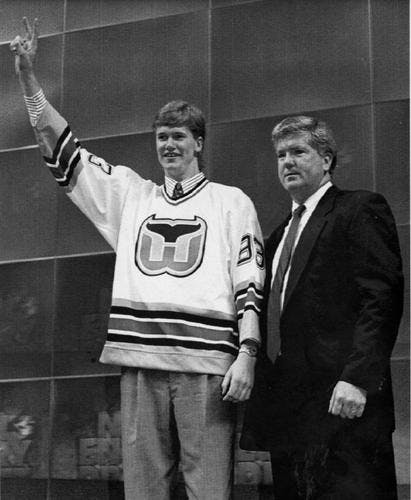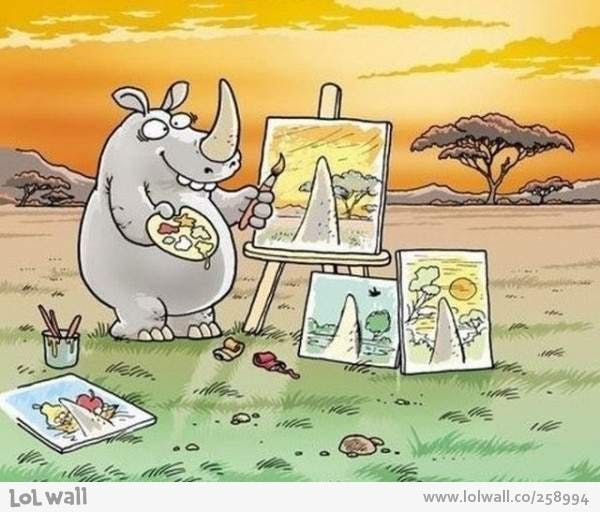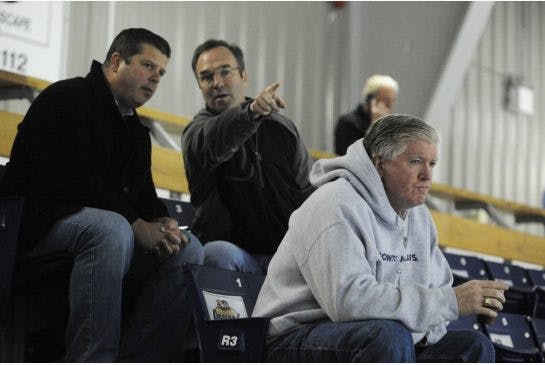Brian Burke: Let’s Make a Deal!
By RexLibris
10 years ago
*The above photo is Brian Burke at the draft with Chris Pronger, a defenseman Burke believed in strongly enough to trade up in the draft order to acquire…hint hint
Amongst NHL media and fans there is the general belief that Brian Burke is one of the best GMs in the league when it comes to trades, specifically that he is better capable of stealing quality talent out of an organization than many or most of his peers.
Being the iconoclastic contrarian that I am, I decided I’d take a look into this to determine whether this was indeed true, and if so to what extent and based on what factors. I also wanted to look further into Burke’s history as a GM and determine where he ranks amongst his peers in the league.
In doing this research I looked at every trade made by the Canucks, Ducks and Leafs while Burke was GM with those organizations. His tenure in Hartford was very brief and was therefore excluded. I’ve also left out his time with the Flames as he has only recently taken over the GM position and prior to that we have no way of determining the impact of his presence on the trades made by his predecessor, Jay Feaster.
My process was to rank every trade as a win, break-even, or loss. Listed below you will see the wins and losses, respectively. I also took note of trades that were made where the featured return was a player noted for “truculence or intimidation” ahead of skill, basically when he traded for an enforcer, in order to determine whether Burke was more likely to spend resources acquiring this type of player.
I then compared Burke’s record with those of David Poile in Nashville, Don Maloney in Phoenix, and Doug Wilson in San Jose in order to provide some perspective through contrast.
My goal here isn’t to criticize or exalt Burke, but instead to draw on historical context to separate fact from narrative. We don’t have Corsi numbers on GMs so we have to cobble together their relative strengths and weaknesses using other means. Past performance relative to organizational context is as good a place to start as any.
Looking at the Field

Burke made 36 trades (excluding his draft-day Sedin trades) during his six-odd years with the Canucks (average of six a year), 35 in three-plus years with the Ducks (nearly twelve a year), and 39 in his roughly four years with the Leafs (just shy of ten per year).
Don Maloney has made 59 trades over six years in Phoenix (about ten a year), while Poile has made 47 trades over about five years (a little more than nine per year), and Wilson about 91 over ten years in San Jose (average of 9.1 a year).
Burke is certainly within the average of these GMs when it comes to the number of moves made per year.The most notable difference is that Burke has been willing to trade players in and out of the perceived core of a team more often than some of his colleagues. As well, Burke has spent relatively short to moderate periods of time with each organization compared to Poile, Maloney and Wilson.
All four GMs have spent time at various stages building a roster, pushing it up the standings, and then trying to put the finishing touches on creating a championship team. Burke was the only one to date who has been successful in this final stage.
In terms of adding those two infamous skill sets, truculence and grit, Burke has made roughly ten trades during his tenure in each organization to intentionally add an enforcer-type of player with NHL potential, that is to say, not solely for the AHL team.
By my count Maloney has made eight trades of a similar variety over his time with the Coyotes. I could only find three trades made by David Poile that qualified as bringing in NHL enforcers. Doug Wilson, over ten years, has made six trades that I could put in this category and this meant including trades for Ben Eager and Raffi Torres, both of which, at the time of their acquisition, were considered functionally productive NHL players.
Considering the reputation of each of these teams, Nashville, Phoenix and San Jose, they vary in terms of perceived size and toughness, so each example can give a little insight into how other GMs approach the philosophy of “team toughness” and adding size to a roster.
The evidence suggests that we are right to believe that Burke likes big players, and believes there is room in hockey for men whose job it is to physically intimidate at the cost of skill. No revelations there, but it is interesting to note the number of transactions he will make in a given year to address an area that many feel is an anachronism in the modern NHL.
He is also given to adding this characteristic through free-agency at least as often as trade, if not slightly more so, than some of his competitors.
Burke: Wrangler or Rustler?

Brian Burke has made some very deft trades in his time. But if we compare the trades he has won to those he has lost, where does he stand? His trade wins are usually spectacular, but in the end does that matter if he loses on a higher number of smaller moves that end up being a net loss for the team he is trying to build?
Here are the trades Burke has made in each organization – those that I believe he won appear first, those that I consider losses follow.
(Note: For clarity, I have left out the Sedin draft day trade, but this was clearly a win and one that has since been a cornerstone of the franchise since the departure of Todd Bertuzzi and Markus Naslund, just as I have left off judging many of his draft-day trades moving picks for picks because of the delay between making the pick and it delivering at the NHL level)
*all data taken from pro sports transactions
Canucks Wins June 1998 to May 2004
Date – Team – Acquired – Relinquished – Trade Partner

Losses

Ducks Wins June 2005 to November 2008
Date – Team – Acquired – Relinquished – Trade Partner

Losses

Maple Leafs Wins November 2008 to January 2013
Date – Team – Acquired – Relinquished – Trade Partner

Losses

Burke lost more trades than he won in Vancouver but at the time was rebuilding a team on the fly and this was at a time when Canadian franchises were struggling to survive. He made some significant roster moves in Bure and Mogilny, in both cases forsaking elite-level talent for a collection of roster pieces. Undoubtedly his crowning achievement, and one that resonates even today amongst Flames fans, was the machinations that allowed him to acquire both the 2nd and 3rd overall selections in the 1999 draft. It was a byzantine affair that, frankly, is worth a read all on its own. That being said, unless the Flames are looking at highly skilled identical twins in the draft again I don’t expect something similar anytime soon.
Burke’s record appears closer to break-even in Anaheim, although the Pronger deal and subsequent Stanley Cup win overshadow any negative impressions of his work there. It is worth noting that following the Pronger deal the remainder of his roster moves, either by addition or subtraction, were mostly minor deals adding depth or toughness. J.S. Aubin, M.A. Bergeron, Jay Leach, Joakim Lindstrom, Ken Klee, and various moves to either move up or down in the draft order were the bulk of Burke’s post-Stanley Cup trades. He was forced into a corner on two occasions via the salary cap, first with the Dustin Penner offer sheet and secondly in having to trade Andy MacDonald for Doug Weight. In both cases his loyalty to Scott Niedermeyer and Teemu Selanne in allowing them the summer to decide on retiring or returning was the primary cause.
Without a doubt Burke’s time in Toronto was his most successful in making trades when taken as a whole, acquiring Gardiner, Franson, Riemsdyk, and-wait for it-Phaneuf for a collection of spare parts, aging veterans, and modest draft picks. His one major mistake was the Phil Kessel deal and if one were to reverse that deal while maintaining all the rest, the Leafs at the end of Burke’s tenure, would have been a dramatically improved team from top to bottom.
If there is hope for Flames fans it is in this last episode as GM that it resides.
Context? We Don’t Need No Stinking Context!

So what were the circumstances in each of these organizations while Burke was there?
Vancouver was rebuilding and fighting an uphill battle financially at the time. They had a few good pieces on the roster, added the twins and then Burke gradually just shuffled around the pieces, never really able to get the team to a high level and spending resources chasing goaltending and toughness.
In Anaheim Burke was gifted while just settling in to his new role with a desperate Kevin Lowe having to trade Chris Pronger. That he won that deal is self-evident in that Pronger was, at the time, one of the best defensemen in the game.
It has been mentioned many times before, but one must also keep in mind that the roster to which Burke added Pronger and lured Rob Niedermeyer was already boasting some impressive talent assmebled by the man who would coach Burke’s opponent in the 2007 Stanley Cup Finals, Bryan Murray.
That this is Burke’s one championship success is, in my opinion, no coincidence.
The Maple Leafs were a highly dysfunctional organization at the time Burke was hired and his mandate was to overhaul the team. He sought to avoid the draft-and-develop process, instead believing that he could add the necessary players through trade and free-agency, both professional and collegiate, to improve the team more quickly. His trades served two purposes: to remove bad contracts and aging veterans and return young players and prospects.
The Vancouver Canuck and Toronto Maple Leafs experiences were closer to rebuilds and bear some, though not all, similarities with the Flames in their current state (establishing identity, acquiring talent).
Brian Burke certainly boasts one of the best trade records in the NHL over the past five years with the bulk of his best work arguably being the most recent with the Maple Leafs. His downfall on the strategy of acquiring good players seems to lie in his insistence on acquiring an abundance of player-types who generally occupy one or perhaps two roster spots on most other teams.
As well, despite his insistence on building a team from the net out, he has spent a significant amount of his time as a GM attempting, but often failing, to secure adequate goaltending. The net effect, if you’ll pardon the pun, is a diluting of the overall skill level of his team and an imbalanced team that cannot compete against those teams who have equal or greater skill and can withstand his teams’ physical play.
In Toronto he eschewed the general practice of building a team through the draft, preferring instead to attract high-profile college free-agents, UFAs, and trading for young players. Had he pursued the draft in addition to his other moves it is my belief that he would still be employed in Toronto and that the Leafs could be a superior team to the one at the time of his departure.
He has proven adept at collecting defensive players and prospects (Jovanovski, Salo, Pronger, Gardiner, Phaneuf, Franson, and so on), but has also traded away a surprising amount of skilled and/or effective forwards, sometimes early on in their development (Bure, Mogilny, Parenteau, MacDonald, Glencross, and Umberger).
During his time in Toronto, however, Burke generally accumulated talent to a greater degree than was lost, and while I will debate the way in which those talents have been deployed and the coaching philosophy, the talents provided to the coaching staff were vastly improved from the time he first joined the organization.
Draft Picks Are For Sissies
For the sake of comparison, let’s take a quick look at the draft history of the Canucks, Ducks and Leafs during Burke’s time at each.
His record with the Canucks is the best in that he added Bryan Allen and Jarkko Ruutu in 1998, the Sedins in 1999, Umberger in 2001 and Kesler in 2003. Those were the draft successes of the Canucks over the course of his six years there.
His brief tenure in Anaheim (three years and change) produced only Bobby Ryan as a draft success.
Under Burke the Leafs drafted Luke Schenn (by trading up to 5th from 7th), Nazem Kadri (7th) and Morgan Rielly (5th). It should be noted that he had traded the draft picks that were ranked 2nd and 8th overall in 2010 and 2011, respectively over the course of roughly four years.
Generally speaking Burke is content to acquire skill in the draft, 2011 notwithstanding when he took Tyler Biggs and Stuart Percy in the first round.
Burke has also shown a predilection to making trades on the draft floor, although these generally have tended to be picks for picks, altering the draft order to either move up or down by adding or forfeting additional picks.
It is also worth noting that many of his expiring contract trades at the deadline have involved recouping both prospects and picks, meaning that the inclusion of the one necessarily dilutes the value of the other. For instance, based on previous trades, Burke could very well trade Cammalleri for a 2014 2nd, a conditional 2015 2nd and a middle-tier prospect rather than a 2014 1st round pick. This isn’t to say that it will happen, only that past behaviour makes it a distinct possibility. Consider his deadline trade of Stempniak as a possible template which recouped Matt Jones, a 2010 4th round pick (Philipp Grubauer) and a 2010 7th round pick, later traded to the Oilers for a 2011 6th round pick (David Broll).
In all likelihood Burke will not be the principal architect of the Flames roster beginning this summer. The initial moves have already been made by Feaster and Weisbrod through the draft and free-agent signings (Hudler and Wideman, especially) and I suspect that their true replacement will be named sometime before the end of the Olympic break and the trade deadline. This means that the June draft and off-season provide the most likely window for the eventual Flames GM to begin making meaningful changes to the Flames organization. One need only see the changes made by Dave Nonis, Burke’s understudy for the better part of a decade, in Toronto to see that this does not necessitate that the new hire will enact a carbon copy of Burke’s management style, but the hiring is likely to provide some insight to a general trend.
Burke has done well in many trades, reshaping teams in his preferred mold. There is no doubt that he has a history of acquiring talented players usually approaching or in the prime of their careers. He is also not afraid to trade away any asset if he feels it will improve the team as a whole. He is fiercely loyal to his players and has, at times, put his organization at a disadvantage on account of this. He aggressively pursues trades but has suggested in that past that he has reasonable limits as to how far he will pursue free agents. All this aside, Burke is focused solely on winning and it is reasonable to believe that if a course of action which he had earlier denounced were open to him as a way of significantly improving his team he would explore alternatives but in the end would not balk.
His deal for Phil Kessel as an alternative to an offer sheet and resignation from the Anaheim Ducks after implying that he would not pursue a job with the Maple Leafs while employed by the Ducks both stand as evidence in this regard.
Drawing Conclusions

*For the record, that’s Dave Poulin pointing something out to Dave Nonis with Burke in the row in front. Poulin has been suggested as a possible GM candidate for the Flames.
The Calgary Flames are in far better hands overall today with Brian Burke than they were under Jay Feaster. Whether he is GM or President of Hockey Operations, his experience and proven abilities with roster management and talent acquisition stand in stark contrast to that of his predecessor.
Is Brian Burke one of the elite GMs in the NHL? I wouldn’t put him in that rarified company, but I would argue that he is one of the better GMs in the league, notwithstanding his penchant for overvaluing players who fall into the enforcer category. He has proven himself to be adept at making trades, with as much of a willingness to take risks as Feaster but with a higher success rate. The first two moves that I believe we can in any way attribute to Burke, the Colborne and Westgarth moves, fit his history perfectly in that in both cases the Flames acquired NHL players with a large frame and relinquished little of immediate value.
Recent articles from RexLibris





